Our Territory
Nishnawbe Aski Nation
Nishnawbe Aski Nation (NAN) evolved out of Grand Council Treaty #9, which was established in 1973 as the regional organization representing the political, social, and economic interests of 49 First Nations in Northern Ontario who are signatories to Treaty No. 9 and Treaty No. 5 (in Ontario). In 1982, the name changed to Nishnawbe Aski Nation. The main objective of NAN is to represent the social and economic aspirations of NAN people at all levels of government in Canada and Ontario until such time as real effective action is taken to remedy the problems and challenges experienced by the people of Nishnawbe Aski and to permit the forces of self-determination to establish spiritual, cultural, social, and economic independence.
NAN’s traditional territory, which encompasses two thirds of the province of Ontario, stretches from the Quebec border in the east to the Manitoba border in the west and from the James Bay and Hudson’s Bay watersheds in north to roughly the Canadian National Railway in the south.
Nishnawbe Aski Nation Organizational Structure
Nishnawbe Aski Nation is a political affiliation of all First Nations within NAN territory.
The Executive Council consists of a Grand Chief, and three Deputy Grand Chiefs.
Organizational Chart
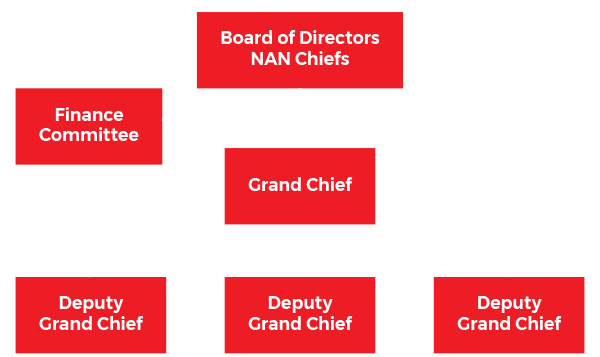
Tribal Councils IN NAN
The majority of First Nations of NAN are grouped into seven Tribal Council areas:
- Independent First Nations Alliance (IFNA)
- Keewaytinook Okimakanak (Northern Chiefs Council)
- Matawa First Nations Council
- Mushkegowuk Council
- Shibogama First Nations Council
- Wabun Tribal Council
- Windigo First Nations Council
Some First Nations are independent of Tribal Council affiliation.
History of Nishnawbe Aski Police Service
The Nishnawbe Aski Police Services was established as a result of a negotiated tri-partite agreement between the Nishnawbe Aski Nation, Canada and the province of Ontario.
The primary goal behind that agreement was the establishment of an Indigenous police service mandated to provide effective, efficient and culturally appropriate policing to the people in the Nishnawbe Aski area.
The Agreement was ratified by the Nishnawbe Aski Chiefs in December 1993 and signed by the negotiating parties on January 14, 1994.
On June 1, 1998, the Nishnawbe Aski Police Service assumed policing from the former Northwest Patrol Unit, administered by the Ontario Provincial Police, except for the First Nations of Big Trout Lake, Weagamow, Muskrat Dam and Pikangikum. An Operational Transition Committee was struck to implement the orderly transfer of administrative and operational matters between the Nishnawbe Aski Police Service and the Ontario Provincial Police. On April 1, 1999 the transition was completed. Muskrat Dam later came on board.
Phase Two commenced January 1, 1998 and the eight First Nations of Wahgoshig, Matachewan, Mattagami, Brunswick House, Chapleau Ojibway, Chapleau Cree, Constance Lake and Aroland were transferred to Division “A”, Nishnawbe- Aski Police Service.
Phase one of the Agreement ran for a period of four years commencing April 01, 1994 in an area identified in the Agreement as Division “A”. All existing First Nation Constable positions plus additional positions, were transferred to the NAN Police Service for a total of thirty-three.
Nishnawbe Aski Police Service Board Governance
Included within the terms of the tri-partite agreement was the requirement for the creation of an independent and autonomous Police Services Board consisting of a representative from each of the Nishnawbe Aski Nation Tribal Councils.
The governance responsibilities of the Board are contained within the agreement and are generally consistent with the responsibilities of Municipal Police Services Boards prescribed within the Police Services Act of Ontario R.S.O. 1990, c. P-15. and with police governance principles throughout Canada.
Board Composition
The Board consists of 8 Directors and 1 ex-offico appointed as follows:
Eight Directors appointed by Tribal Councils, one from each of the following:
- Independent First Nations Alliance
- Keewaytinook Okimakanak (Northern Chiefs Council)
- Matawa First Nations Council
- Mushkegowuk Council
- Shibogama First Nations Council
- Wabun Tribal Council
- Windigo First Nations Council
- Unaffiliated First Nations within NAN
- Ex-officio Director appointed by NAN Executive
Mandate of the NAPS Police Services Board
The tri-partite agreement states that the Police Service Board shall be independent and autonomous and shall be responsible for governing NAPS and for providing and implementing, through the Chief of Police, planning, direction and policy for NAPS.
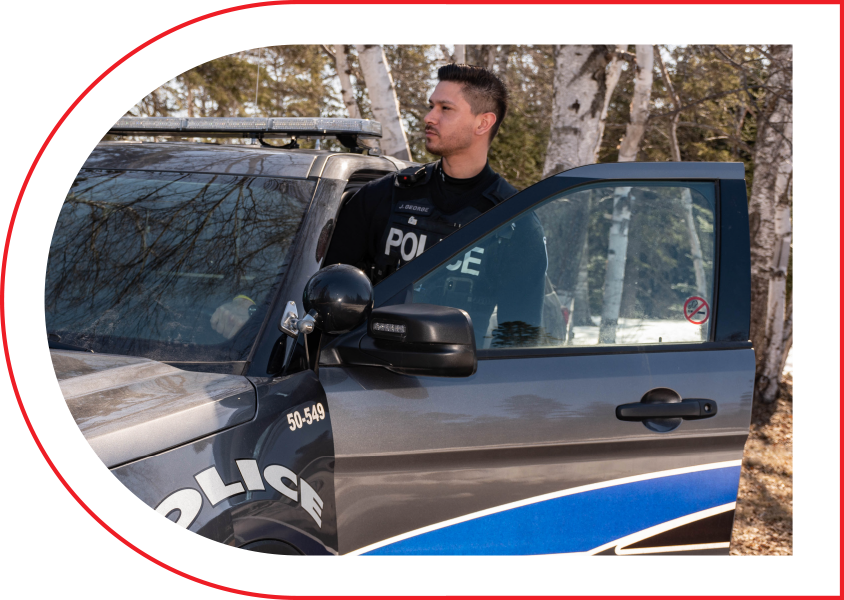


Uniform Organizational Chart
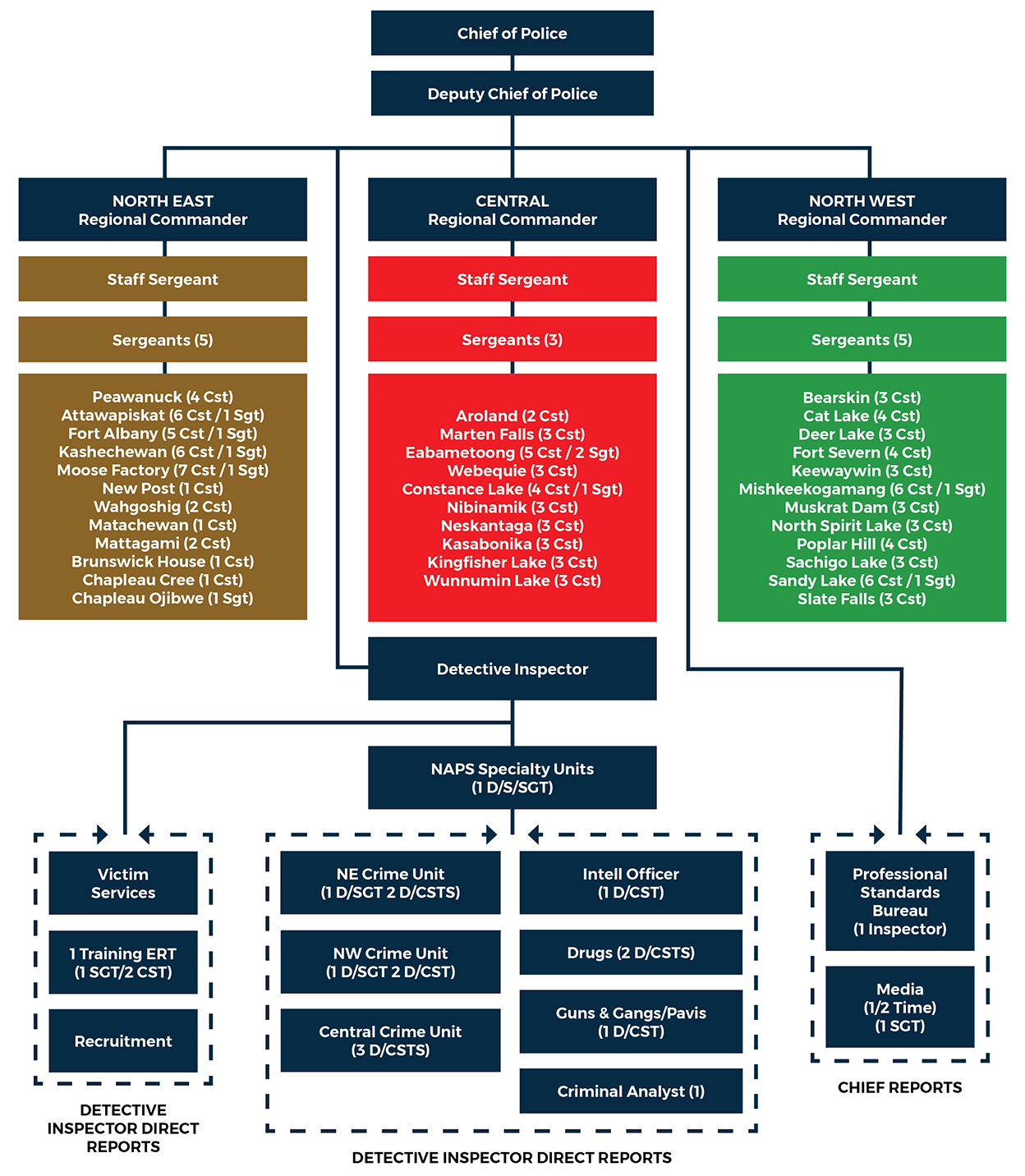
Civilian Organizational Chart
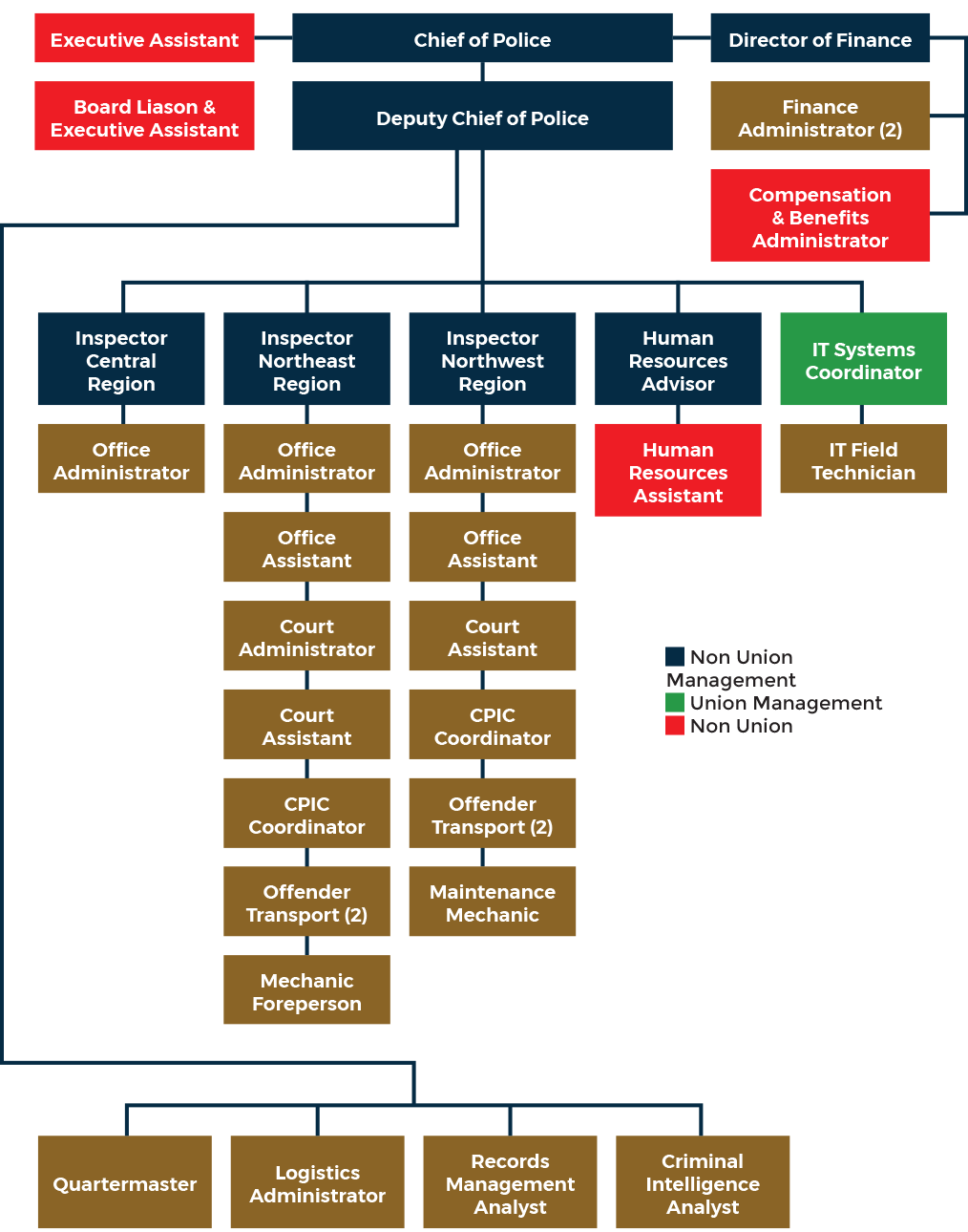
What Did Our People Say?




Feedback From Frontline Officers
Frontline officer feedback on incentives for the Police Service
100%
100%
80%
70%
100%
Objective
NAPS is dedicated to becoming the employer of choice. In order to assist in achieving this goal, recruitment is undergoing a complete reboot.
NAPS strives to inspire candidates through a progressive, efficient, fair and impartial recruiting strategy, while promoting the mission statement of the Nishnawbe Aski Police Service.
| Goals |
|---|
| Social Media Enhancement |
| Educational Partnerships |
| Human resource strategic plan Onboarding review (interview recruits and hiring process) Increase recruitment teams |
| Develop Regional recruitment teams |
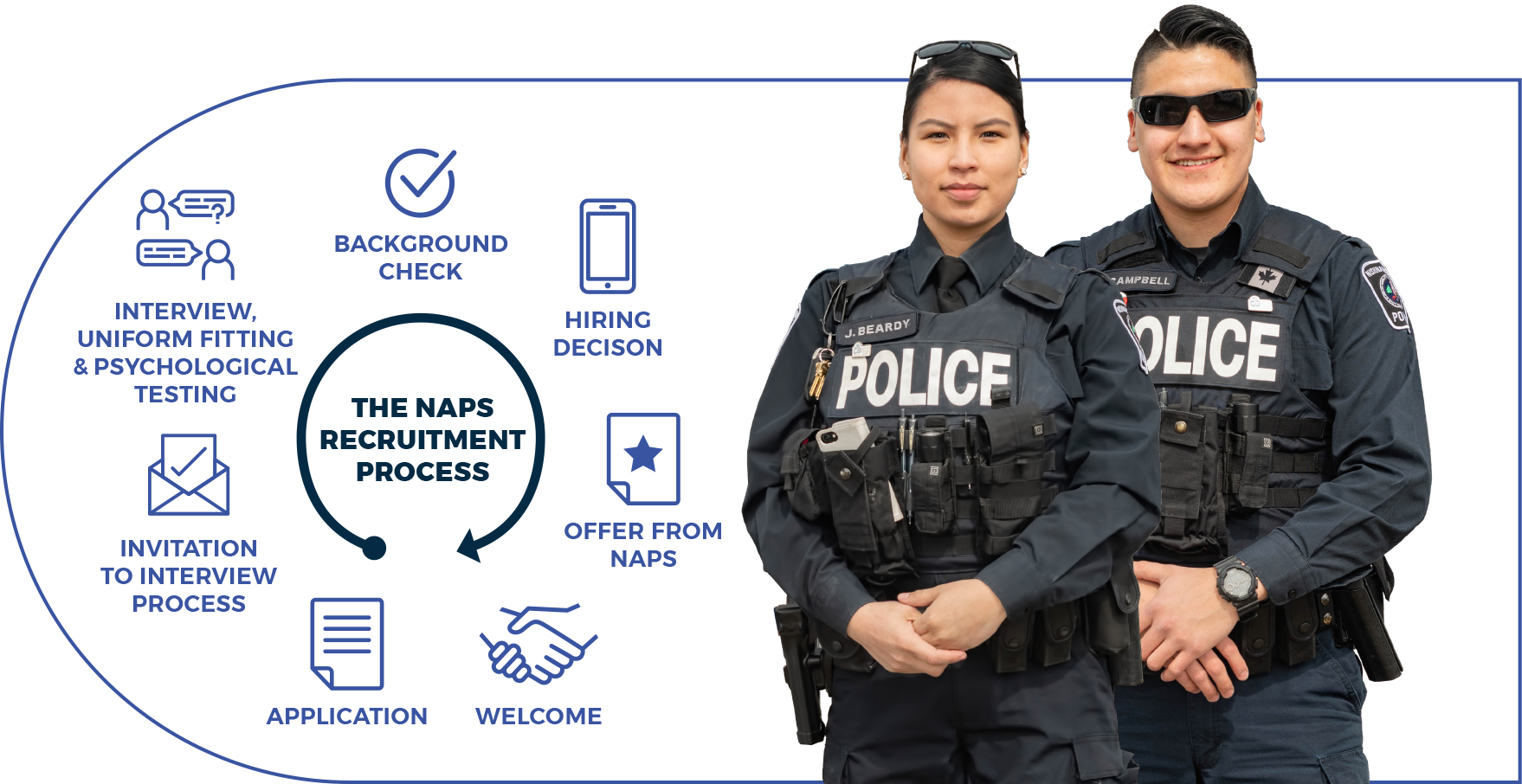
Objective
At Nishnawbe Aski Police we know people are our greatest resource and we strive to retain the best talent. Management will implement idea’s that will allow our service to retain and attract potential candidates through various retention strategies.
| Goals |
|---|
| Succession planning (merit based promotions) / opportunities and back fill gaps while staff is absent |
| Accommodations |
| Increase front line officers and their training in remote communities |
Objective
All members are trained to provide the optimal level of police services that best reflects the needs of our NAN Communities.
NAPS operates with modern equipment providing superior operational and deployment efficiency in a challenging and constantly changing environment.
| Goals |
|---|
| Block training enhancement |
| Training tree (established guidelines) |
| Equipment audit (review all vehicles, equipment, detachments) |
| Maximizing technology |
| New detachments in remote communities |



Objective
Reinforcing that our priority is our people and we manage through the lens of wellness. We are the healthiest version of ourselves to enter into the new era of policing.
| Goals |
|---|
| Fitness programming Fitness – explore how to get access and promote fitness through a strategic plan and meaningful incentives. |
| Reboot CIRST – Critical Incident Response Team |
| Mental and Emotional health awareness training |
| Increase specialized unit response to Major Crime |
NAPS Leased Aircraft: PC-12 (Pilatus)
9
Seats
1800
LBS Payload
110-135
Hours of Flying Time Per Month
25-28
Flying Days Per Month
130
Passengers Transported This Month
- The plane be reconfigured if required and seats can be physically removed to accommodate freight
- The NAPS plane and charters can start as early as 5:30 am and some days not end till midnight
- Passengers vary from government, dignitaries, board, contractors, prisoners, officers, and civilian staff
Charters
Using local aviation companies, NAPS will easily use on average 10-12 charters in one month. There are many days when NAPS has 2 charters along with the NAPS leased aircraft flying on the same day. The demand for charters to assist NAPS with daily operations is significantly increasing each month.

Fort Albany
Constables: 5Population: 5211
Aroland
Constables: 3Population: 735
Attawapiskat
Constables: 9Sergeants: 2
Population: 3673
Bearskin Lake
Constables: 3Sergeants: 1
Population: 948
Brunswick House
Constables: 2Population: 852
Cat Lake
Constables: 4Sergeants: 1
Population: 822
Chapleau Cree
Population: 505Chapleau Ojibwe
Sergeants: 1Population: 40
Constance Lake
Constables: 4Sergeants: 1
Population: 757
Deer Lake
Constables: 4Population: 1354
Eabametoong
Constables: 6Sergeants: 2
Population: 2721
Fort Severn
Constables: 6Population: 728
Kasabonika Lake
Constables: 4Population: 1191
Kashechewan
Constables: 10Sergeants: 1
Population: 1,680
Keewaywin
Constables: 4Population: 821
Kingfisher
Constables: 5Population: 627
Marten Falls
Constables: 3Population: 810
Matachewan
Constables: 1Population: 37
Mattagami
Constables: 2Population: 586
Mishkeegogamang
Constables: 9Sergeants: 2
Population: 1967
Moose Factory
Constables: 12Sergeants: 2
Population: 4824
Muskrat Dam
Constables: 3Population: 467
Neskantaga
Constables: 3Population: 492
New Post
Constables: 1Population: 373
Nibinamik
Constables: 3Population: 543
North Spirit Lake
Constables: 3Population: 498
Peawanuck
Constables: 4Population: 527
Poplar Hill
Constables: 5Sergeants: 1
Population: 684
Sachigo Lake
Constables: 4Population: 969
Sandy Lake
Constables: 8Sergeants: 1
Population: 2,296
Slate Falls
Constables: 3Population: 293
Wahgoshig
Constables: 2Sergeants: 1
Population: 128
Webequie
Constables: 4Population: 943
Wunnumin Lake
Constables: 4Population: 706




